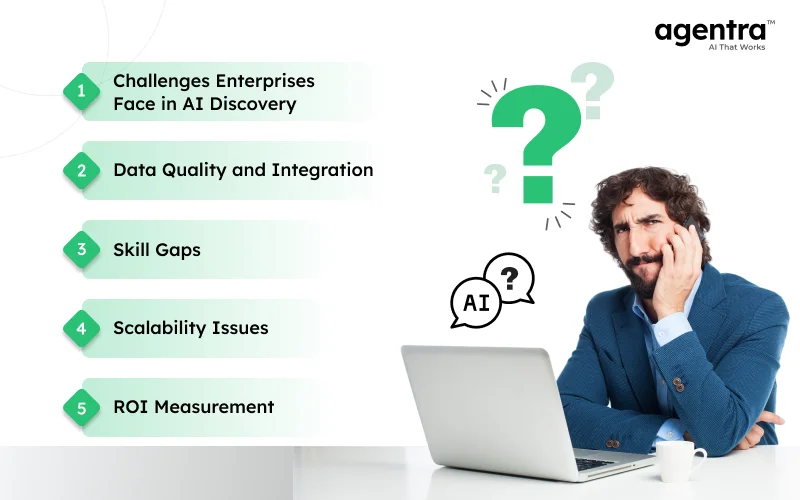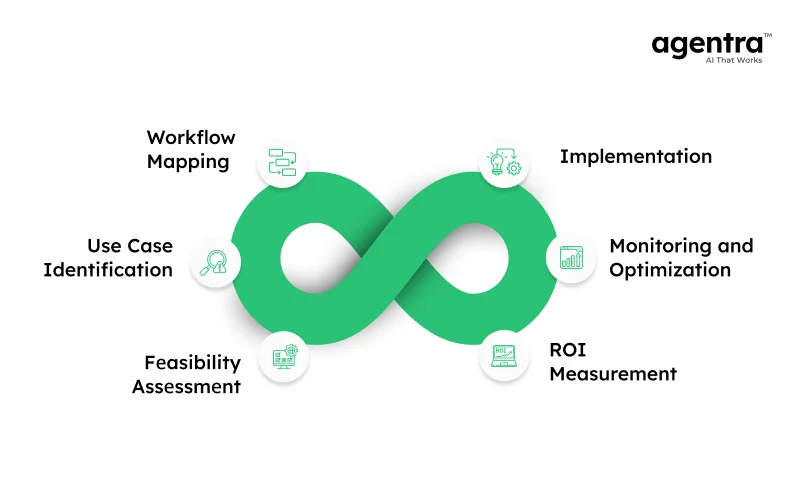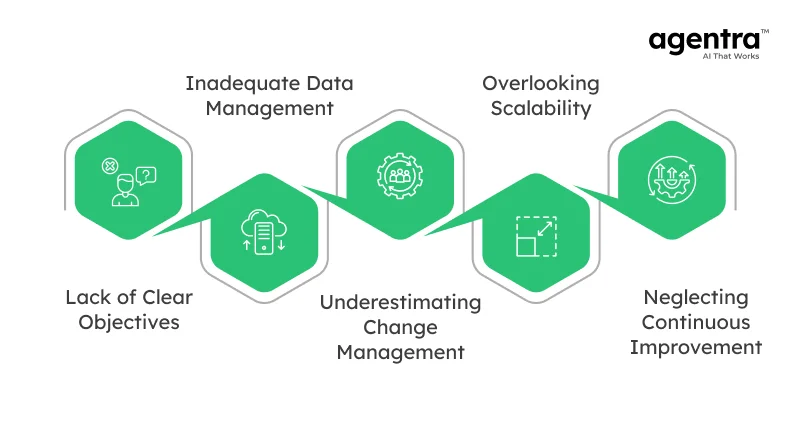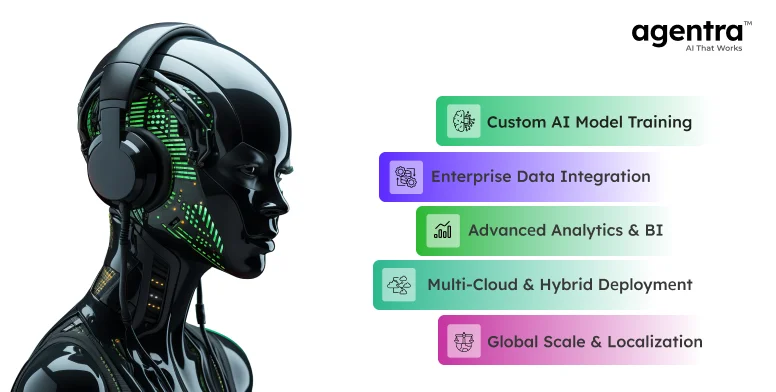A mid-sized manufacturing entrepreneur experienced increasing pressure to remain competitive. The CTO realized that conventional approaches were no longer sufficient and adopted an enterprise AI platform to transform operations.
The leadership team mapped current processes, identified inefficiencies, and highlighted areas such as:
- Inventory management
- Quality control
- Customer service
They used a gradual strategy, starting with small pilots like chatbots to assist customers. The initial successes built trust and paved the way for scaling AI across departments.
Key steps in their AI workforce platform journey included:
Workflow Mapping: Identifying bottlenecks and high-impact processes.
Pilot Projects: Testing AI in areas that deliver quick wins.
Resolving Objections: Addressing concerns about data quality, adoption resistance, and ROI.
Scaling with ROI: Measuring cost reductions, productivity, and customer satisfaction.
Workforce Training: Teaching employees to work with enterprise AI tools.
The outcome: Streamlined operations, measurable ROI, and a stronger competitive position within the industry.
Challenges Enterprises Face in AI Discovery

Enterprises often encounter several obstacles when adopting AI technologies:
Data Quality and Integration
- AI needs clean, accurate, and structured data.
- Data silos across systems create barriers.
- Poor integration limits AI effectiveness.
Skill Gaps
- Shortage of skilled AI professionals.
- Complex tools require specialized knowledge.
- Slows down development and deployment.
Scalability Issues
- Enterprise AI must handle growing data volumes.
- Solutions should adapt to business expansion.
- Poor scalability creates operational bottlenecks.
ROI Measurement
- Difficult to track AI’s financial impact.
- Lack of clear performance metrics.
- Makes investment justification challenging.
Cultural Resistance
- Employees fear job loss due to AI.
- Low familiarity with new tools leads to pushback.
- Resistance slows cross-team adoption.
Overcoming these challenges requires the right strategy, technology, and change management to ensure enterprise AI platform adoption delivers real business value.
The Roadmap: From Workflow Mapping to ROI Fast

A structured approach streamlines the AI discovery process:
Workflow Mapping
- Document current processes.
- Identify bottlenecks and inefficiencies.
- Highlight areas for AI intervention.
Use Case Identification
- Choose functions for automation.
- Align initiatives with business goals.
- Focus on high-impact opportunities.
Feasibility Assessment
- Check technical readiness.
- Assess resource requirements.
- Evaluate risks and challenges.
Implementation
- Develop AI models and tools.
- Integrate with existing systems.
- Ensure smooth user adoption.
Monitoring and Optimization
- Track AI performance metrics.
- Gather user feedback.
- Adjust for continuous improvement.
ROI Measurement
- Calculate cost savings.
- Measure efficiency gains.
- Compare outcomes with goals.
By following these steps, enterprises can reduce risk, maximize returns, and build a sustainable roadmap for an AI deployment platform.
Common Pitfalls in Enterprise AI Adoption (and How to Avoid Them)

There are typical pitfalls in enterprise AI adoption and ways of preventing them:
Lack of Clear Objectives
- AI projects falter without defined goals.
- Success becomes difficult to measure.
- Clear objectives make results business-aligned.
Inadequate Data Management
- Poor data quality leads to misguided insights.
- Limited access reduces system efficiency.
- Strong governance ensures accuracy and accessibility.
Underestimating Change Management
- Employees may resist new AI tools.
- Lack of training slows adoption.
- Clear communication builds trust and smooth transitions.
Overlooking Scalability
- Small-scale designs limit growth.
- Systems can be overwhelmed by future demands.
- Scalable architecture supports long-term success.
Neglecting Continuous Improvement
- Static systems quickly become outdated.
- Business needs evolve faster than outdated AI.
- Regular reviews maintain alignment with goals.
Companies that address these pitfalls can achieve seamless AI adoption, sustainable growth, and a strong competitive edge.
How Agentra Simplifies Enterprise AI Discovery

Enterprise AI companies like Agentra provide a comprehensive platform to simplify AI adoption:
Custom AI Model Training
- Build AI agents tailored to unique business goals.
- Ensure accuracy, relevance, and efficiency.
- Enable continuous learning and improvement.
Enterprise Data Integration
- Connect seamlessly with existing systems.
- Enable end-to-end workflow automation.
- Maintain data consistency across departments.
Advanced Analytics & BI
- Access real-time dashboards for better decisions.
- Use predictive analytics to forecast trends.
- Turn raw data into actionable insights.
Multi-Cloud & Hybrid Deployment
- Deploy securely across private, public, or hybrid clouds.
- Meet compliance and governance standards.
- Ensure flexibility for diverse IT environments.
Global Scale & Localization
- Operate seamlessly across regions.
- Support multilingual, localized experiences.
- Adapt to cultural and market-specific needs.
Using enterprise AI solutions like Agentra, organizations can accelerate AI implementation, automate operations, and drive measurable growth — without compromising on security or scalability.
Future of AI Discovery in Enterprises
The future of AI discovery in business includes:
Increased Automation
- AI will handle more complex tasks with minimal human intervention.
Enhanced Personalization
- Solutions will create more tailored experiences for customers and employees.
Improved Decision-Making
- AI will provide deeper insights for data-driven choices.
Ethical AI Practices
- Businesses will embrace ethical codes and enterprise AI strategy to help in the responsible use of AI.
Collaborative AI
- Artificial intelligence will collaborate with human beings, boosting productivity and innovation.
By keeping up with those trends, businesses will be able to be at the center of AI innovation.
Closing Thoughts
Enterprise AI discovery is about strategy, clarity, and the right tools. By mapping workflows, adopting AI workflow automation tools for enterprise, and measuring ROI, organizations can transform operations and stay competitive.
FAQs
Q1. Why is AI discovery important for enterprises?
Agentra helps enterprises define optimal workflows, focus on impactful use cases, and ensure measurable business value from AI projects.
Q2. What are the main challenges enterprises face when adopting AI?
Agentra addresses issues like data quality, skill gaps, scalability, ROI tracking, and cultural resistance through an integrated platform.
Q3. How can enterprises map workflows for AI readiness?
Agentra’s workflow mapping tools visualize current processes, identify bottlenecks, and highlight where AI can deliver the most value.
Q4. What is a phased approach to AI adoption?
With Agentra, enterprises can start with small, high-impact pilots, evaluate results, and scale successful AI initiatives across departments.
Q5. How can ROI be measured for AI projects?
Agentra provides real-time analytics to track cost savings, productivity, and efficiency improvements — ensuring measurable ROI.




